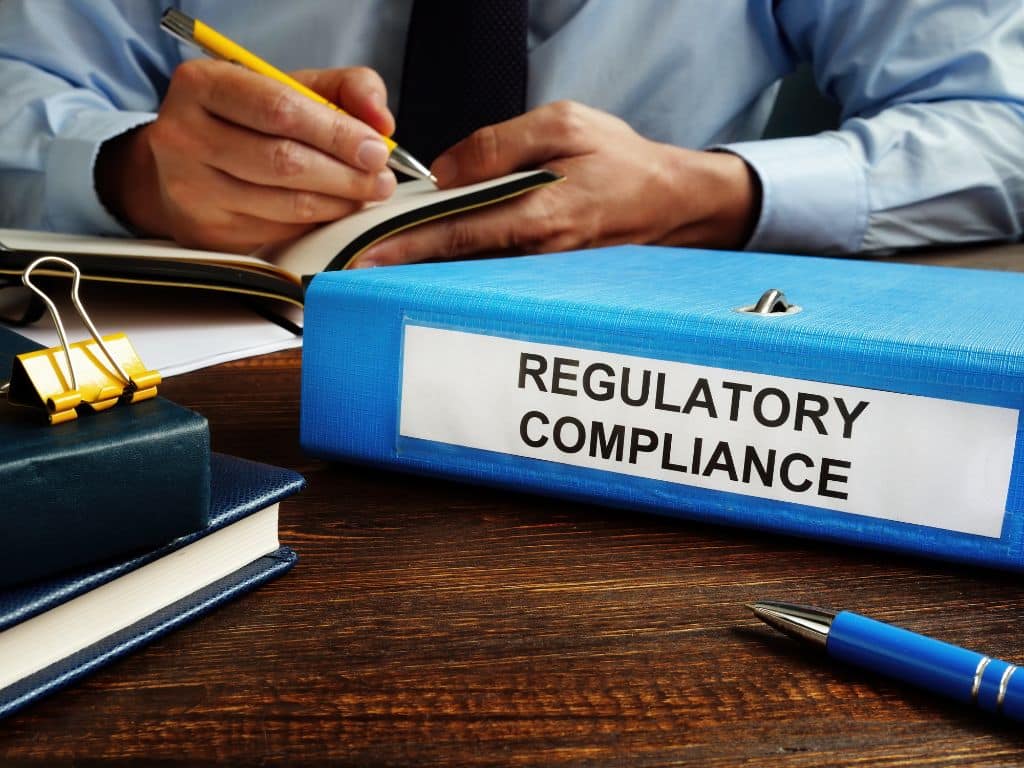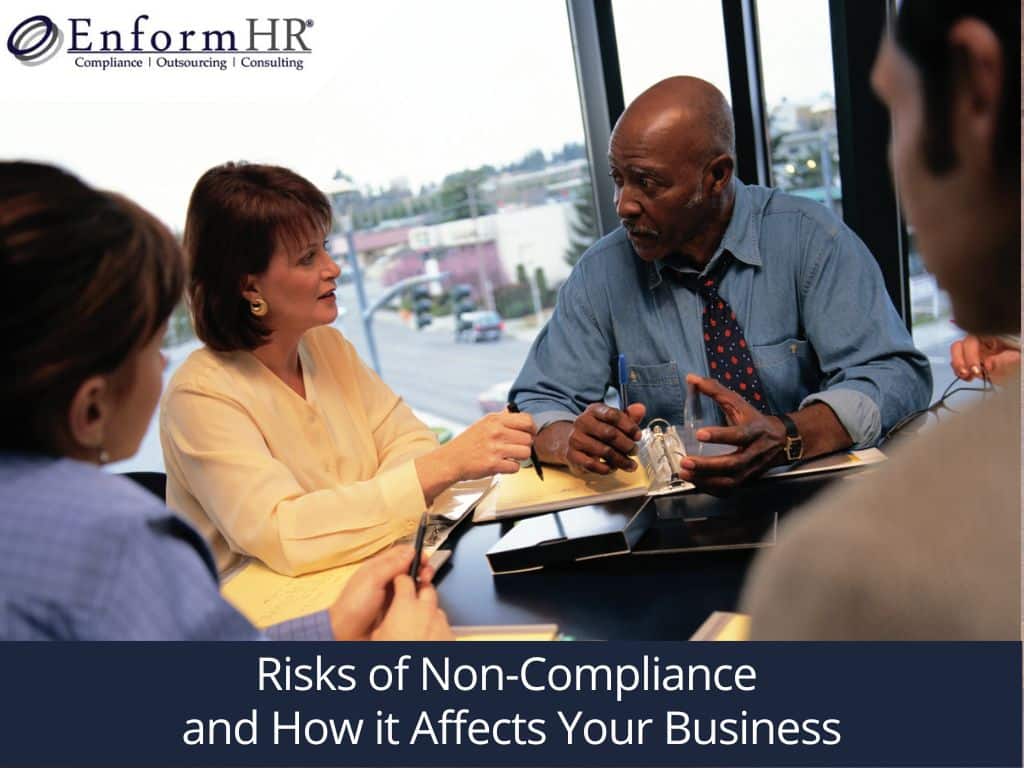Risks of Non-Compliance and How it Affects Your Business
Rules, rules, rules… they’re everywhere! Sometimes, rules can feel stifling, trivial, and sometimes even downright unnecessary. Rules help provide people with guidelines within which to conduct ourselves, and when those rules are broken, there can be serious consequences. Businesses are not immune to rules, and similarly, there are laws and regulations in place that establish expected standards in which businesses operate.
What is Non-compliance in Business?

In the business world, compliance is a catch-all phrase associated with “following the rules” and translates to, “defining and implementing the policies, procedures, and training to ensure employees understand, acknowledge and comply with all applicable laws and regulations.” Compliance falls under a few categories: legal, human resources, and government. Additionally, compliance can fall within multiple authority levels: federal, state, and local.
What Are the Risks for Non-Compliance?

This can be a lot to unpack for businesses, as there are numerous laws and regulations that affect businesses, especially when it comes to your employees. Many of these laws are written to protect the workforce physically, such as with the OSH-Act (Occupational Safety and Health Act), from discrimination, such as with ADA (Americans with Disabilities Act), Title VII of the Civil Rights Act, ADEA (Age Discrimination in Employment Act of 1967), the Equal Pay Act of 1963, and ensuring fair labor practices, such as with the Fair Labor Standards Act.
It can feel impossible to keep up with the laws themselves, let alone changes, updates, and additional stringencies at the state and local levels, especially for small businesses. But the risks of non-compliance can surely leave any business owner shaking in their boots. The truth is, mistakes and non-compliance can cost you big. Here are a few examples of just how much non-compliance can cost you:
- Mistakes or Technical Violations on I-9 forms: $252-$2,507 for first offenses, and $1,161-$2,322 for second and subsequent paperwork offenses per violation.
- According to Paycor, in 2019, ICE delivered 6,500 Notice of Inspections and reached $14.3 million in fines, penalties and forfeitures.
- Violations of the Americans with Disabilities Act: $75,000 -$150,000
- Failing to pay overtime under the Fair Labor Standards Act: $1,000 per violation plus back pay, and $10,000, even potential criminal prosecution, for willful violations
- Violations of the Occupational Safety and Health Act: Up to $15,625 per day
- If discrimination is found under the Equal Employment Opportunity Commission, compensatory and punitive damages may be awarded to claimants:
- Up to $50,000 for employers with 15-100 employees
- Up to $100,000 for employers with 101-200 employees
- Up to $200,000 for employers with 201-500 employees
- Up to $300,000 for employers with more than 500 employees
In addition to the monetary cost of non-compliance, there are also intangible risks to consider, such as damaging your organization’s reputation with both consumers and employees, losing high-performing talent, and detriment to employee morale and satisfaction. While these effects can sometimes be difficult to quantify, their effect can often be felt long-term.
Implementing Effective Compliance Strategies
The groundwork for implementing a compliance strategy starts with identifying and understanding what regulations apply to your company and creating policies and procedures that adhere to those regulations. Much of this can be integrated into your Employee Handbook; it’s impossible to memorize every law and regulation, so having a detailed document like a handbook and easy-to-access procedures that you, your managers, and your staff can rely on and reference can help alleviate the burden of having to remember extensive processes and the fine details. Every employee is responsible for understanding expectations.

Every employee across various levels needs to understand compliance expectations. So, once you have policies and procedures at the helm, the next step is ensuring your staff is properly trained. This means educating your employees on policies laid out in the Employee Handbook, establishing a procedure on how employees can relay questions and concerns, implementing checks and balances, and initiating compliance training for your managers. Trainings should be diversified and detailed but also interactive and relevant. You don’t want your managers to burn out, but instead, be motivated through transparent communication that lays out both the need and benefit of compliance training. Companies can do this by offering their trainings incrementally, presenting material that offers a reflection on real-life situations and contains exercises that can develop your staff’s existing skill sets and engage teamwork.
Now, laying the groundwork for your compliance is not a “set-it-and-forget it” feat. As mentioned, regulations and laws are constantly changing, so dedicating a team or individual to overseeing compliance and auditing your policies and trainings regularly will help keep your organization up-to-date. Doing so will also help you identify any gaps or weaknesses in your policies or trainings, and allow you to quickly mitigate them.
Do Not Underestimate the Importance of Staying Compliant
It’s also worth noting that lawsuits associated with non-compliance can cost you an exuberant amount of time and legal fees. With all of this said, doesn’t it seem like all this time could be much better spent on growing and running your business? It may sound scary, but the fact is non-compliance can have serious consequences, and often, some businesses are not even aware of non-compliance. Unfortunately, unawareness does not beget leeway or clemency to the tangible and intangible costs of non-compliance.
This is why making sure your business adheres to all applicable laws and regulations is so paramount. At EnformHR, our seasoned and educated Human Resources professionals can help lessen the burden of ensuring your business operates compliantly. From recruiting and onboarding, performance management, employee handbooks, to workplace investigations, benefits administration, and employee training, we can help you implement best practice policies and procedures that are HR-compliant.
Reach out to our team today to see how we can help you.
Published on: March 29, 2022
Updated on: April 20, 2023




